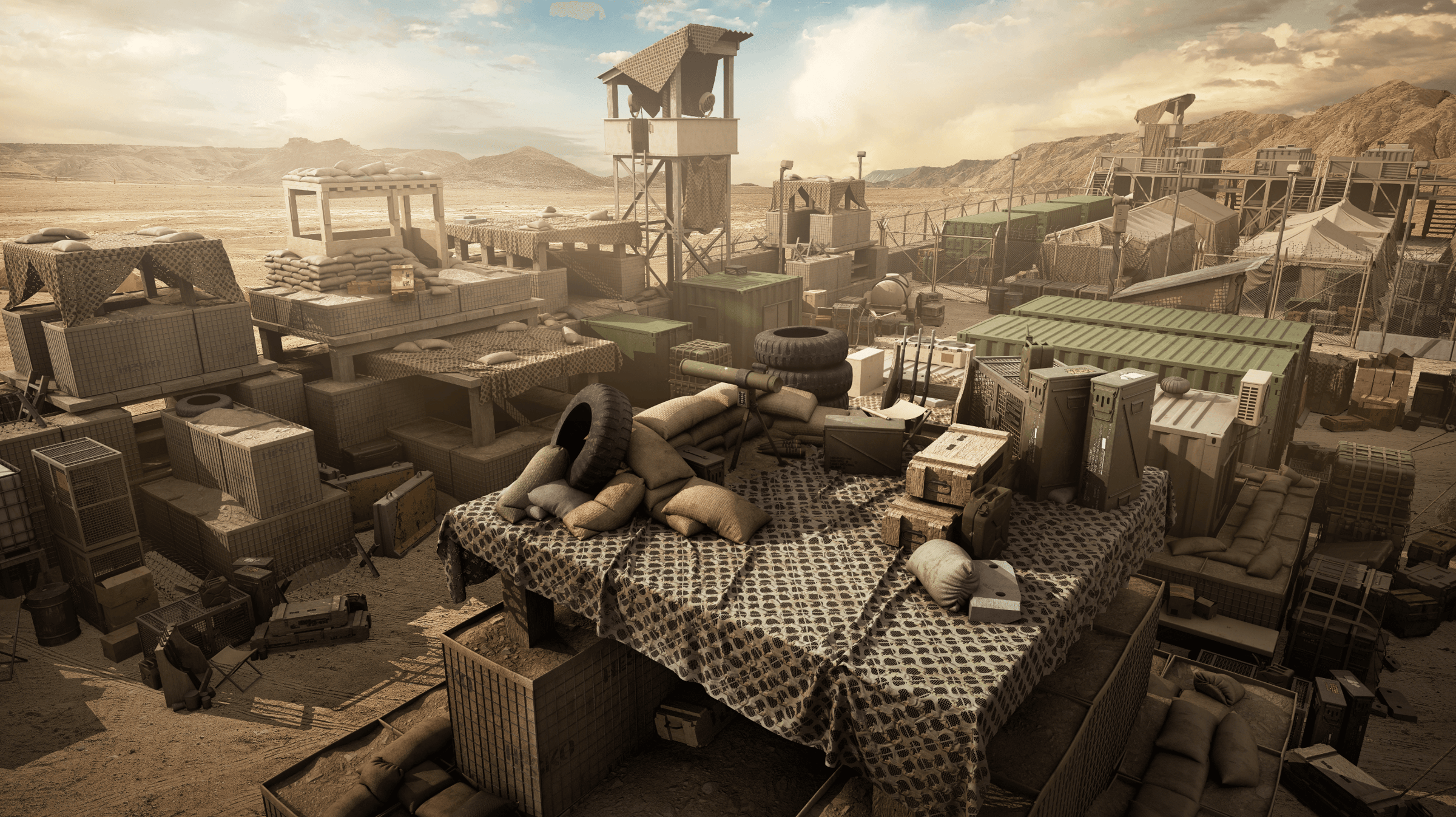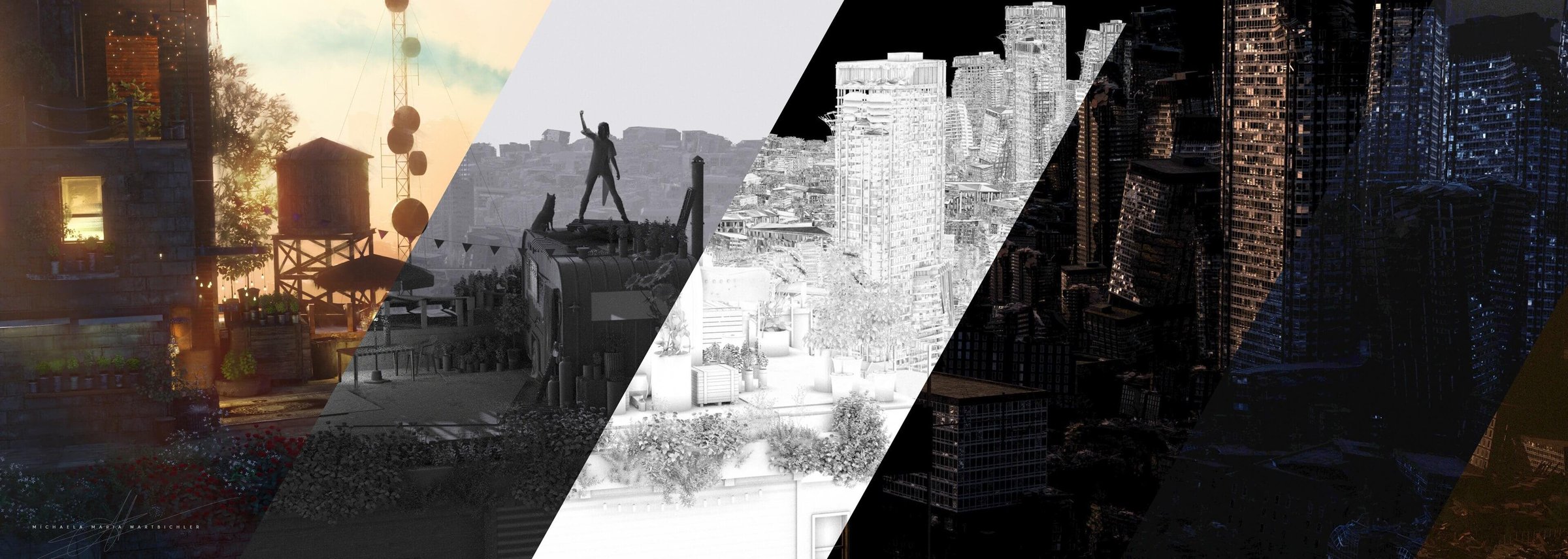Like many of you, we were stunned when we first saw Gustaf's hypnotic, abstract approach to the Post-Apocalypse #KB3Dcontest. We wanted to sit down with him and discuss his process and mindset for creating such an original piece...
How long have you been an artist?
I've been an artist for as far back as I can remember... constantly drawing. Mostly very bad drawings, but kept it up pretty much all the way from elementary school through high school. This segued into a passion for comic books and illustration, so I enrolled at San Jose State University, majoring in Illustration. At the time, the illustration program at SJSU was part of the graphic design program, so I got exposed to that as well. By the time I graduated, I was working at an entry-level design position at a local advertising and marketing agency, so I spent the next several years doing graphic design job by day and freelance illustration by night. The original plan was to eventually go freelance with the illustration stuff... but the agency world proved too lucrative to give that up. Fast forward fifteen or so years... I had grown up in the agency world, working my way up from junior designer to creative director, concentrating mainly on motion and interactive projects, but I found myself ultimately dissatisfied with the type of work I was doing. Long story short, I decided to ditch it all and reboot my career. I took a year-long sabbatical, during which time I finally got serious about Cinema 4d... and relaunched as a freelance motion designer.
What is your process before starting a project like this?
For this piece, I followed my "normal" process: Ideation, exploration, iteration, evaluation, repetition, and execution. Ideation is the collection and documentation of your thoughts... which invariably leads to the generation of new ideas and approaches. Exploration is researching references and expanding on those ideas. Iteration is the generation of multiple solutions so as to not get locked into your first attempt. Evaluation is the constant testing of your solutions to find the very best manifestation of your intention. Repetition is engaging in this process over and over (and over). And execution is the brute-force needed to power through and actually get the thing DONE.
There’s nothing more daunting than a blank page… the empty pixel. To get things kicked off, I used Scapple to map out some thoughts, keep track of concepts, and organize them into some semblance of a narrative.

I always use references. Back in my illustration days, I learned exactly how important references are, so I usually spend a good chunk of time researching.
Gathering and curating some reference is crucial to my process for refining and clarifying the visual direction of the piece.
I further refined the visual vocabulary I was after by narrowing my reference down to a single mood board. Here you can see I was originally leaning towards a very dark, saturated look (which I eventually eased up on…)
As for sketching... yes! I'll always make time for going back to my first love (drawing). This piece, in particular, didn't require a ton of sketching, but I did do a fair amount of doodling to try to knock some concepts loose.  Music is such a huge portion of the overall experience, so I knew I wanted to sketch out a rough framework to use as a foundation. The mighty Moog One ended up being the perfect instrument to lay this foundation.
Music is such a huge portion of the overall experience, so I knew I wanted to sketch out a rough framework to use as a foundation. The mighty Moog One ended up being the perfect instrument to lay this foundation.
I created the base underscore by layering several tracks of synthesizer improvisations in Abelton Live. I augmented this over several iterations with sound effects, found sounds, and other instrumentation.
I exported combinations of tracks and stems, combining everything in Digital Performer for final mixing.
It took a while to find the story I wanted to tell. As this was a KitBash3d contest, I began with the building models. Here I’m just exploring and iterating… experimenting to see what kind of interactions I can create.
I continued this iterative process by “sketching” with some of my reference images… Here I’m just putting sequences together to test out visual narrative threads.

This process continued throughout the various stages of production, progressively updating the storyboard with renders and tests as I completed them.
The editing process actually began before anything was animated. I first put together a rough board-o-matic using my rough thumbnails… testing the pacing and feel against the soundtrack.
As the process continued, the editing timeline slowly evolved as more and more shots were fleshed out.
A key milestone in the project is the viewport motion test. This is where I test all the camera movements and animation, evaluating what works and what doesn’t.
Now the real heavy work begins. The piece was created in Cinema 4D and rendered with Redshift. Each scene required texturing the buildings and objects, lighting the environment, and setting up the movement and animations required to move the story along.

This continued to be an extremely iterative process. I’d get the scene to a ready state, render out some tests, evaluate, tweak, then repeat as necessary. Along the way I’d import these test renders into the editing timeline, keeping a perpetual eye on the big picture. “Final” (is there ever anything final?) images were rendered out of Cinema 4D as openEXR image sequences and imported into After Effect for compositing. This is where I can take the base image and really tweak and finesse it… adding layers of atmosphere, particles, smoke, lighting effects, and overall adjustments.
“Final” (is there ever anything final?) images were rendered out of Cinema 4D as openEXR image sequences and imported into After Effect for compositing. This is where I can take the base image and really tweak and finesse it… adding layers of atmosphere, particles, smoke, lighting effects, and overall adjustments.
The openEXR format allows me to embed multiple passes that enable me to isolate elements of the 3D render for detailed adjustments. Quite the timesaver, especially when this shot here took upwards of eight or nine hours to render.
Composited shots were rendered out of After Effects as ProRes QuickTime clips and imported into the editing timeline. Finishing image adjustments were made with a combination of Lumetri Color and Red Giant’s Magic Bullet suite. Film emulation and grain was applied with Film Convert Nitrate.

In an effort to keep things mostly sane during a two-month production time-frame, I used this Google Sheet to keep an eye on things. Status, notes, and render times were all tracked here.
![]()
What is the story or emotion you wanted to evoke with your piece? What is… The Last Canticle?
As for the emotion I wanted to create, I knew I wanted to have some kind of balance between the typical ominous and dark post-apocalyptic vibes and something more hopeful. This being a KitBash3d contest, I knew I wanted to showcase the awesome destroyed buildings in the kit...

But I also knew I wanted to construct some type of narrative... How did this happen? How did we get here? What will happen now? When I started the project, Covid-19 was hitting China pretty hard, so I began to think along the lines of some type of global economic collapse due to some type of contagion, etc... I was also thinking in terms of layers of political and environmental issues, so there's a bit of that sprinkled in as well. 
But I didn't want the whole thing to be a downer... so the tag at the end with the mysterious cube rising up toward the light... that's my stab at the light at the end of the tunnel.
And finally, why do you make art?
I make art because I have to. Not in the sense that I am forced to... but rather that I cannot NOT make art. I feel we've all been given unique tools through which we can try to make sense of the world (even through such a crazy and surreal time as this global pandemic) and its our privilege to share that.
These are dark times the world is going through, have you thought of making anything for #BrightArtDarkTimes
Its really awesome that your guys gave away your Utopia kit for #BrightArtDarkTimes ! I've definitely been percolating some ideas!
---

Gustaf Fjelstrom is a motion designer and founder of Botched Creative. He is also a musician, illustrator (and recovering creative director)
specializing in conceptual design, style frames, and storyboards
for title sequences, branding/identity spots, and promotional campaigns.
AND ALSO BY NIGHT…

Throughout this journey, there has been one constant: music. Bass guitar and synthesizers, mostly. For 15 years he was one-third of the instrumental progressive rock trio Maximum Indifference. In these post-Indifference years, he's continued to release music under his own name. March of 2019 marked his 10th official release.
To see more of his work make sure to check out his website




